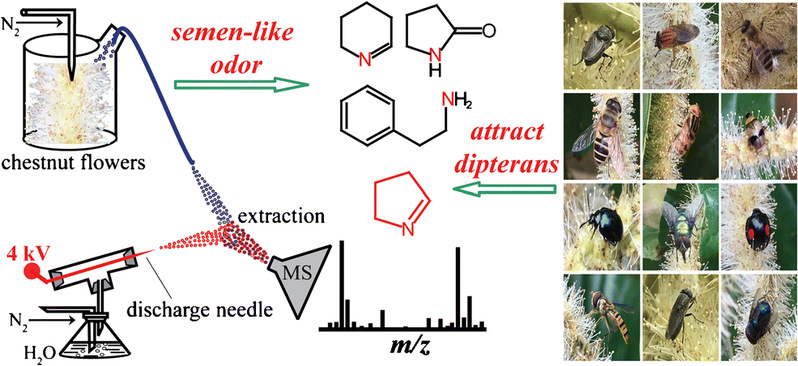Abstract
Knowledge about the chemical composition of floral volatile organic compounds (VOCs) is valuable in biological studies as well as for the flavor, cosmetic, and fragrance industries. The flowers of Chinese chestnut (Castanea mollissima) emit a distinctive semen-like odor; however, the chemical composition and biological role for the semen-like odor of chestnut flowers remain scarcely studied. Herein, we report the floral VOCs and the pollinators of chestnut flowers. A fast method based on a neutral desorption (ND) device coupled to extractive atmospheric pressure chemical ionization mass spectrometry (EAPCI-MS) was developed for the rapid identification of VOCs from freshly collected chestnut flowers without any chemical pretreatment. Chemical identification was performed using high-resolution MS analysis in combination with tandem MS analysis and whenever possible was confirmed by the analysis of standard reference compounds. Twenty volatiles were identified, most of which are nitrogen-containing. Out of the identified volatiles, 1-pyrroline is known to have a semen-like odor and is probably also responsible for the semen-like odor of the chestnut flowers. Four nitrogenous VOCs of chestnut flowers, including 1-pyrroline, 1-piperideine, 2-pyrrolidone, and phenethylamine, were also common in other semen-like odor flowers such asPhotinia serrulata,Castanopsis sclerophylla, andStemona japonica, suggesting similar chemical origin. The main visitors of chestnut flowers were dipteran species, such asEristalis tenax,Eristalis arvorum,Episyrphus balteatus,Lucilia sericata,Chrysomya megacephala,Chrysochus asclepiadeus, andAdalia bipunctata. Our results suggest that the chestnut flowers and other semen-like odor flowers may present a new type of sapromyophily. This study also indicates that ND-EAPCI-MS provides more sensitive and simpler detection of many VOCs (particularly nitrogen-containing VOCs) than GC-MS and therefore can be used to complement traditional approaches for the higher chemical coverage of VOCs analysis.
Graphical abstract

 Molecular analysis of semen-like odor emitted by chestnut flowers using neutral desorption extractive atmospheric pressure chemical ionization mass spectrometry.pdf
Molecular analysis of semen-like odor emitted by chestnut flowers using neutral desorption extractive atmospheric pressure chemical ionization mass spectrometry.pdf